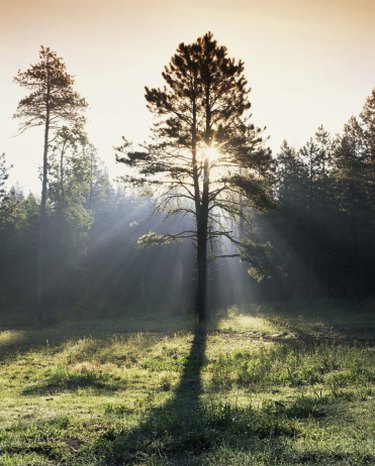
Clay soil can be a problem for gardeners and homeowners. Clay is slow-draining, heavy and often alkaline, and there are few trees for which clay soil is ideal. Fortunately, several pines and other evergreen trees can survive and even thrive in clay soil, which does have the advantage of retaining water well and being generally nutrient-rich. To help you decide which pines are right for your area, look at a hardiness zone map and consult with a local expert before you plant any trees.
Ponderosa Pine
Video of the Day
Valued as landscape trees as well as for their lumber, ponderosa pines are hardy and adaptable, and will grow in a wide range of soil types and conditions, including clay. They have a natural range that covers large portions of the western United States, where they can reach heights up to 150 feet. The trees grow with an open pyramidal formation and are adorned with long, green needles and large, red-brown pine cones. The bark of the ponderosa pine is deeply furrowed, becoming increasingly irregular with age. These trees are resistant to most diseases and pests and are drought-tolerant, though moist but well-drained soil with full sun is best.
Video of the Day
Austrian Pine
Large evergreens that are often used as a specimen trees, Austrian pines grow to about 40 feet tall, with a pyramidal form that becomes rounded and flat-topped as the trees age. They tolerate a wide range of soil conditions that would ordinarily be unfavorable, including drought, alkaline soils, low nutrients and heavy clay. Ideal conditions include full to partial sun and moist, well-drained soil. The needles are 5 inches long, dark green and stiff, and the pine cones are about 2 inches and brown. These trees may be susceptible to Diplodia tip blight and pine sawfly larvae in some areas.
Colorado Spruce
Also known as blue spruce, this broad, dense, pyramid-shaped evergreen is known for the light blue-green color of its foliage. With 1-inch needles and 2 1/2- to 4-inch cones, these trees are slow-growing and typically reach 30 to 60 feet. Dwarf cultivars are available. Native to the Rocky Mountains but widely planted elsewhere, the Colorado spruce is the most drought-tolerant of all spruces, but usually does not do well with too much water. Like most spruce trees, it performs well in clay soil, But well-drained, moist soil with full sunlight is ideal. It will not grow in shade.